More actions
Salartarium (talk | contribs) m Give exact restriction for MMJU due to addition of Rorquals and continuing balance changes |
Salartarium (talk | contribs) m Added Mobile Sanguine Harvester, update template for mobile cyno + disrupter + CRAB |
||
| Line 1: | Line 1: | ||
{{Update|Need to add Mobile Cynosural Beacons, Mobile Warp Disruptor deployables, and CONCORD Rogue Analysis Beacon}} | |||
'''Mobile Structures''' are deployed by individual pilots in space to provide a wide variety of services. First introduced in 2013 with [[Rubicon]], Capsuleers can use these structures to aid their own activities, such as providing storage, increased rewards or resources, or a microjump maneuver; or they can be used to disrupt enemies: such as by starbase siphoning, jamming probes and cynosural fields. Some of these structures can help to replace modules on the ship, such as a Tractor Beam or a [[Cloaking]] Device, allowing more fitting slots for other modules. | '''Mobile Structures''' are deployed by individual pilots in space to provide a wide variety of services. First introduced in 2013 with [[Rubicon]], Capsuleers can use these structures to aid their own activities, such as providing storage, increased rewards or resources, or a microjump maneuver; or they can be used to disrupt enemies: such as by starbase siphoning, jamming probes and cynosural fields. Some of these structures can help to replace modules on the ship, such as a Tractor Beam or a [[Cloaking]] Device, allowing more fitting slots for other modules. | ||
| Line 65: | Line 66: | ||
=== Variations === | === Variations === | ||
The basic MTU is reasonably cheap, costing around 7 million ISK. There are two advanced variations of the MTU, the 'Packrat' Mobile Tractor Unit and the 'Magpie' Mobile Tractor Unit. The Packrat variant has a stronger tank, while the Magpie has a longer tractor beam range. Both have increased tractor velocities, but the Magpie has the fastest. Both also have increased sensor strength, making them harder to scan down. Both are considerably more expensive than the basic MTU, with Magpies running at hundreds of millions of ISK. The [[BPC]]s for these units can be found from [[Ghost Site]]s. | The basic MTU is reasonably cheap, costing around 7 million ISK. There are two advanced variations of the MTU, the 'Packrat' Mobile Tractor Unit and the 'Magpie' Mobile Tractor Unit. The Packrat variant has a stronger tank, while the Magpie has a longer tractor beam range. Both have increased tractor velocities, but the Magpie has the fastest. Both also have increased sensor strength, making them harder to scan down. Both are considerably more expensive than the basic MTU, with Magpies running at hundreds of millions of ISK. The [[BPC]]s for these units can be found from [[Ghost Site]]s. | ||
There is also the Mobile Sanguine Harvester, a special variant from the [[Crimson_Harvest_(2020)|Crimson Harvest]]. This variant has been modified by Blood Raiders to collect frozen corpses rather than wrecks. | |||
{| class=wikitable style="font-size:90%;" | {| class=wikitable style="font-size:90%;" | ||
| Line 103: | Line 106: | ||
| 30,000 | | 30,000 | ||
| 300 | | 300 | ||
|- | |||
| Mobile Sanguine Harvester | |||
| 1000 | |||
| 125 | |||
| 100 | |||
| 20,000 | |||
| 20,000 | |||
| 60,000 | |||
| 50 | |||
|} | |} | ||
Revision as of 09:51, 21 November 2022
Reason: Need to add Mobile Cynosural Beacons, Mobile Warp Disruptor deployables, and CONCORD Rogue Analysis Beacon
Mobile Structures are deployed by individual pilots in space to provide a wide variety of services. First introduced in 2013 with Rubicon, Capsuleers can use these structures to aid their own activities, such as providing storage, increased rewards or resources, or a microjump maneuver; or they can be used to disrupt enemies: such as by starbase siphoning, jamming probes and cynosural fields. Some of these structures can help to replace modules on the ship, such as a Tractor Beam or a Cloaking Device, allowing more fitting slots for other modules.
They are distinct from Citadels and starbases; which take longer to deploy, are much more expensive, and are owned by player corporations rather than individuals. Mobile structures are more similar to jettison containers, in that interacting with another pilot's structure does not cause a CONCORD response.
In short, mobile structures fill a variety of roles and can affect nearby players in aspects of survivability, utility, espionage, bounties, and defense. As such, they have rapidly become used in nearly every walk of life within New Eden, from the systems with 1.0 security to Null security space, and especially even in unknown wormholes.
Mobile Depot
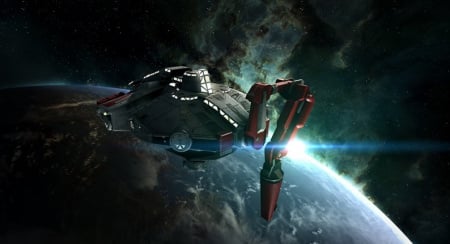
Mobile Depots act as an in-space fitting service and storage facility. Once you deploy a depot, you can use it to refit your ship's modules and subsystems, move items between it and your cargohold, and move drones between your cargohold and drone bays. A Mobile Depot takes up only 50 m3 of space and will easily fit in most frigates. It can hold 3,000 - 4,000 m3 once deployed.
Deploying a Mobile Depot takes 60 seconds. Once in space, it will last for 30 days, at which point it will vanish with its contents. However, interacting with it will reset this 30-day timer--so remember to bookmark it. It can be scooped back to your ship's cargohold at any time. Any contents will appear in space in a cargo container at that time. A Mobile Depot can only be accessed or scooped up by its owner; you cannot launch it for use by other players at this time.
Other players can scan down your Mobile Depot with combat probes and attack it (receiving a suspect flag, not a criminal flag; CONCORD will not intervene!). At 17,500 HP, the Depot is not particularly tough, but if it's damaged to 25% of its shield hitpoints it will go into a "reinforced mode" for two days. During this period it cannot be damaged further, giving you enough time to either defend it or scoop and escape. After the two-day reinforcement timer is up, if it has not been repaired, it can be destroyed and its contents looted. Although scooping the mobile depot and immediately deploying it does take it out of reinforcement it does not repair the shields. If the shields are still below 25% when redeployed and have not had enough time to repair shields to 26% or above on its own when attacked it will not go into reinforcement but will be destroyed. You will receive no notification that your depot has been attacked, but will receive a killmail should it be destroyed. If you don't want to repair the mobile depot, you can scoop it into your ship's cargo bay, dock at a station, repackage it, and it will be fully repaired. During the anchoring period, the mobile depot can be targeted and destroyed. If it's damaged to 25% of its shield or less it will not go into reinforcement and will continue to take damage until it's destroyed even after the anchor timer is finished. If for some reason the enemy loses lock on it the mobile depot can be relocked and take damage until destroyed.
Mobile Depots are often deployed at safe spots, allowing you to swap fittings and store any excess items. This can be useful while ratting, as you can store excess loot in the depot and swap fittings depending on which NPCs you are fighting. A Mobile Depot is also useful when traveling through dangerous areas of New Eden, since you can travel fit on the way there and then refit for whatever purpose at your destination.
Another useful trick when flying in dangerous areas of space is to keep a Mobile Depot and some warp core stabilizers in your cargohold. If you're attacked and don't think you can win the fight, deploy the mobile depot, wait out the 60-second activation, then refit your ship with warp core stabilizers and make your escape.
Variations
There are three variants of the Mobile Depot: the standard Mobile Depot (built by players using NPC-sold BPOs), and two "improved" variants (the BPCs for which are found in Ghost Sites), the 'Yurt' Mobile Depot and the 'Wetu' Mobile Depot. The 'Wetu' Mobile Depot takes up a bit more space in your ship's cargohold (100 m3 vs 50 m3), but has more cargo capacity (4000 m3 vs 3000 m3), and has a higher sensor strength, making it more difficult for other players to scan down the location of your Depot. The 'Yurt' takes this last attribute to its extreme, with a very high sensor strength making it very difficult for all but the most skilled players to scan down.
The basic Mobile Depot is reasonably cheap (around 1 million ISK), but the more advanced versions are one or two orders of magnitude more expensive.
| Name | Volume (m3) | Capacity (m3) | Sensor strength (points) |
|---|---|---|---|
| Mobile Depot | 50 | 3000 | 50 |
| 'Wetu' Mobile Depot | 100 | 4000 | 250 |
| 'Yurt' Mobile Depot | 50 | 4000 | 400 |
The minimum scan strength to scan down a 'Yurt' Mobile Depot, which is the hardest structure to scan down in the game, is 69 probe strength.
Mobile Tractor Unit
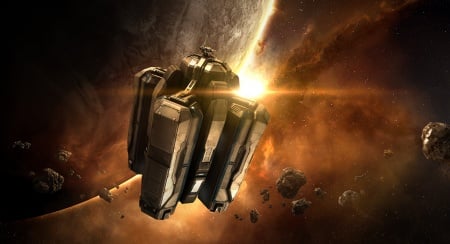
A Mobile Tractor Unit (or MTU) is essentially a massive cargo container with a tractor beam bolted on. Once deployed, it uses a single tractor beam to pull in any wrecks and cargo containers. It has a range of 125 km, with a 1,000 m/sec tractor velocity, and a 27,000 m3 cargohold. Deployment time is only 10 seconds, and the MTU will last 2 days in space before despawning. The MTU is only accessible by its owner. When destroyed it drops partial loot the same way a destroyed ship does.
The MTU may not be deployed within 5 km of another MTU, within 50 km of stargates or stations, or within 40 km of a player-owned starbase. It has 50,000 hitpoints. However, unlike the Mobile Depot, it does not enter reinforced mode and can be immediately destroyed. Like the Mobile Depot, the only consequence for shooting another player's MTU is a Suspect flag; CONCORD will not intervene.
The MTU targets the closest item first, tractors it in, and loots it. Due to the "closest first" behavior, you can't use more than one MTU per site, as they will interfere with each other and pull nothing in at all - unless you place them so far apart (250 km for the basic unit) that they don't interfere with each other
The MTU has become extremely popular despite its cost, particularly for looting mission rats. Though not as fast at tractoring and looting as a ![]() Noctis, the MTU continues to loot a field even when you're not there, and deposits wrecks in an easy-to-salvage group around itself. This can allow your mission ship to salvage while running the mission, using either a utility high slot or salvage drones.
Noctis, the MTU continues to loot a field even when you're not there, and deposits wrecks in an easy-to-salvage group around itself. This can allow your mission ship to salvage while running the mission, using either a utility high slot or salvage drones.
Some systems have seen an increase in organized griefing centered on Mobile Tractor Units. Similar to ninja salvaging and stealing, a gang will take up residence in a high activity missioning area and scan down MTUs. They'll then aggress the MTU, attempting to bait the missioner into engaging them. As with ninja looters, the options for dealing with them are fairly limited. Engaging the griefer will give you an engagement timer with the suspect and allows him to legally shoot back at you. Not engaging will cost you both your loot and the cost of the MTU. Orbiting the MTU at close range mitigates this heavily. As soon as you see them warp into your pocket you can empty the contents of the MTU into your hold and scoop the unit. They will be left with a mission pocket that you have already looted and are likely to move on.
MTUs do not loot wrecks that are not yours. There are some griefers that prey on this misunderstanding. After arriving in your mission pocket they may drop an MTU of their own – hoping you will engage it on the presumption that it will steal your loot, and collect it for the griefer. It is best to ignore these rogue MTUs as apart from moving wrecks, they won't affect you. Even if the griefer warps out and leaves their MTU behind, they can monitor you in local to gank you if they see you've become a suspect, warping right back in with some friends.
Variations
The basic MTU is reasonably cheap, costing around 7 million ISK. There are two advanced variations of the MTU, the 'Packrat' Mobile Tractor Unit and the 'Magpie' Mobile Tractor Unit. The Packrat variant has a stronger tank, while the Magpie has a longer tractor beam range. Both have increased tractor velocities, but the Magpie has the fastest. Both also have increased sensor strength, making them harder to scan down. Both are considerably more expensive than the basic MTU, with Magpies running at hundreds of millions of ISK. The BPCs for these units can be found from Ghost Sites.
There is also the Mobile Sanguine Harvester, a special variant from the Crimson Harvest. This variant has been modified by Blood Raiders to collect frozen corpses rather than wrecks.
| Name | Tractor velocity (m/s) | Range (km) | Volume (m3) | Shield | Armor | Structure | Sensor strength (points) |
|---|---|---|---|---|---|---|---|
| Mobile Tractor Unit | 1000 | 125 | 100 | 10,000 | 10,000 | 30,000 | 50 |
| 'Packrat' Mobile Tractor Unit | 1250 | 125 | 125 | 15,000 | 15,000 | 40,000 | 150 |
| 'Magpie' Mobile Tractor Unit | 1500 | 175 | 100 | 10,000 | 10,000 | 30,000 | 300 |
| Mobile Sanguine Harvester | 1000 | 125 | 100 | 20,000 | 20,000 | 60,000 | 50 |
Mobile Cynosural Inhibitor

The Mobile Cynosural Inhibitor is almost invaluable within 0.0, creating easy to set up inhibitors that can severely limit the enemy's ability to hot-drop on top of your units or gates. It prevents all normal cyno fields (but not covert cynos) from activating within 100km of the inhibitor. It takes two minutes to set up, has a 300 m³ volume, and will stay in space for 1 hour. However, unlike the other mobile structures, this one cannot be reclaimed and will stay in space for that one hour or until someone blasts it apart. It is inherently designed for small or medium gangs as it cannot stay active for long under heavy fire due to a lack of HP that comes from the structure itself. One other limitation is it cannot be deployed in any location that would cause 2 fields to overlap as well as being expensive to produce (150m for the BPO alone).
Even with all those limitations, it will still become a common sight in 0.0 due to the massive benefits that come from being able to control owned space and combat zones so effectively.
Mobile Scan Inhibitor
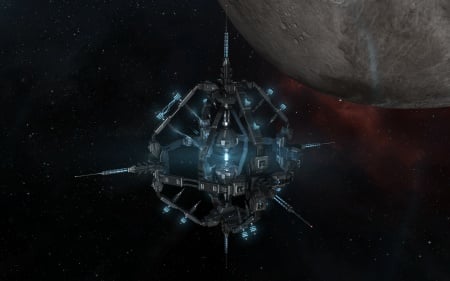
The Mobile Scan Inhibitor provides a way to hide ships within a 30 km radius from the probe and directional scanning. Ships within this radius will also find their own instruments rendered inoperable. The mobile scan inhibitor itself is not invisible, but highly visible to combat probes and directional scans. Therefore the usage of this structure does not completely hide somebody's presence. It will be very clear to others that somebody is hiding something - it is only unknown what is hidden. Even more importantly: while the ship is hiding inside the structure's radius its sensor systems are inoperable. Finally, it is important to note that in known space, those hidden will still be visible in local chat. Therefore its use is far more convenient for fleets operations than for lone travelers. Activation time is 1 minute and it cannot be retrieved - it is only a one-time use disposable structure. The structure self-destructs after one hour of operation.
Mobile Observatory
Mobile Observatories are deployables designed to counteract cloaking ships. When an Observatory is deployed, it "pings" the system every ten minutes, with a 40% chance each ping to decloak each cloaked ship in a system that has exhausted its cloak stabilization timer. The chance is "rolled" for each cloaked ship in the system individually: it is not a 40% chance to decloak every cloaked ship in the system together, but a 40% chance calculated for each ship.
The cloak stabilization timer lasts for 15 minutes from the point at which a ship activates its cloak. It is visible to the cloaked pilot above the circular capacitor / heat / hitpoints indicators at the bottom centre of the screen.
Mobile Observatories require Anchoring III—which means that Alpha clones cannot deploy them—and take up 100m3 of cargo hold space. It takes 10 minutes to deploy one, and it issues its first ping when it finishes deploying. A Mobile Observatory has 30,000 hit points. Mobile Observatories last for up to 2 hours, so they cannot be left to ping a system for days. They cannot be deployed in highsec, Pochven, wormholes, deadspace, or Abyssal deadspace. They cannot be scooped back up after anchoring.
Mobile Micro Jump Unit
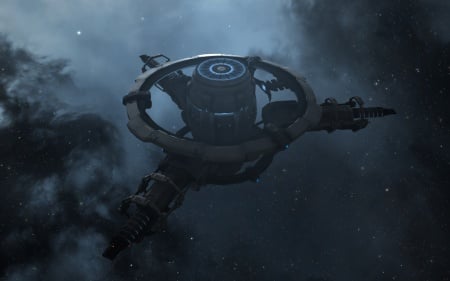
The Mobile Micro Jump Unit launches a ship 100 km in whatever direction the ship is facing, similar to the Large Micro Jump Drive module. It has no cooldown between uses or limit to how many ships can use it at once, but it does have a warm-up time of 12 seconds before initiating the jump. It can be used by ships with less than 1,000,000,000kg mass and can be used both by friendlies and enemies. It has a 1-minute activation time, a lifetime of 2 days, and cannot be retrieved - it is only a one-time use disposable structure.
Mobile Siphon Unit
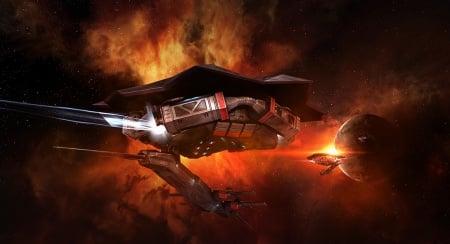
Mobile siphon units were used to steal materials from player-owned starbasess that were used to mine moon goo. The structure has no use after the introduction of moon mining
Encounter Surveillance System
The Encounter Surveillance System used to be a player-deployed mobile structure but is now a built-in feature of sovereign nullsec systems.
General limitations
All Mobile Structures have a minimum distance they have to be away from certain structures in order to be deployed (see below) and all of them are capable of being destroyed by anyone and the attacker will only get a suspect flag for it so a watchful eye needs to be on your goods as often as you can. Some of them can be relatively easy to scan down due to low sensor strength which makes them rather vulnerable, however, the Wetu and Yurt Mobile Depot variants are very resilient to probing, the Yurt, in particular, boasting a hefty 400 sensor strength against all sensors which makes it very hard to pin down for all but the highest skilled probers.
External links
- Better living through mobile structures, a Dev Blog introducing the first set of mobile structures
- More deployables from super friends, a shorter Dev Blog detailing the small siphon unit variations and the first pass at the ESS.
- The Next Generation of Mobile Structures, an EVE Dev Blog on the second round of mobile structures.
